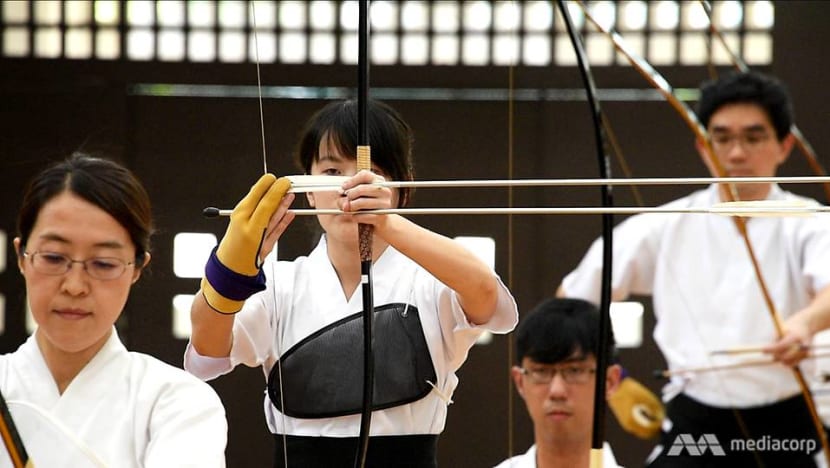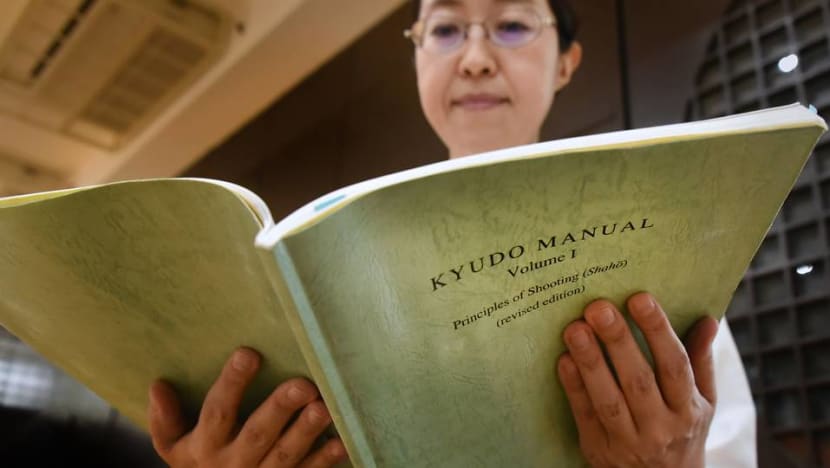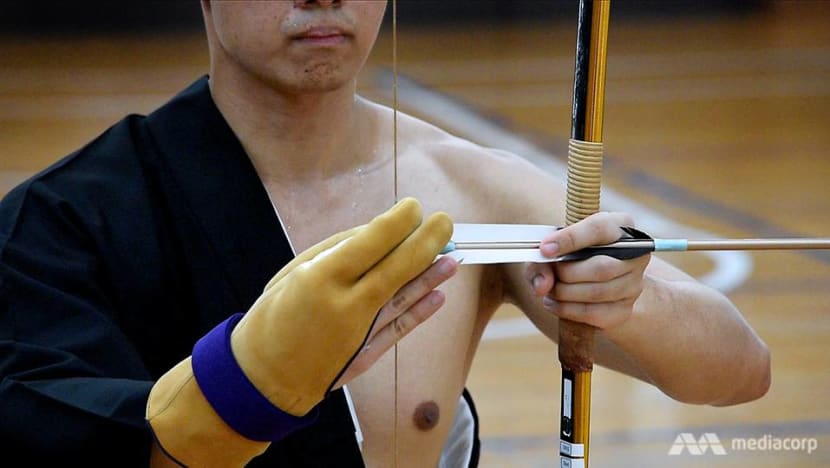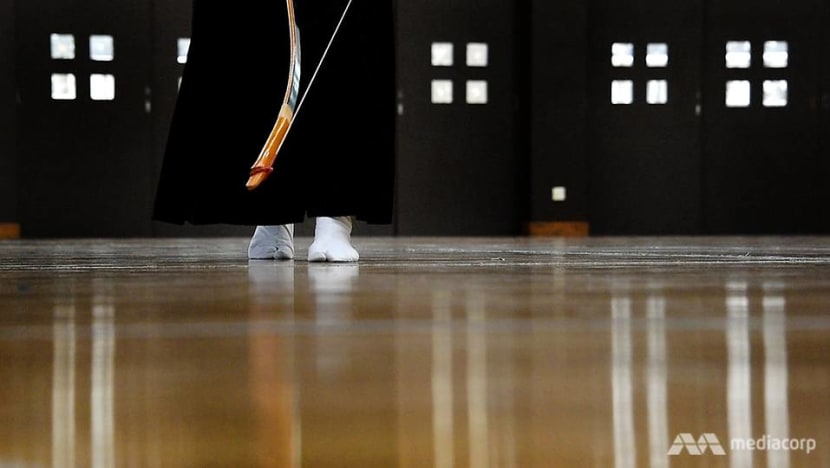Take a bow: Young Singaporeans who thrive on ancient Japanese archery

A kyudo practitioner performing one of the eight stages to shoot an arrow. (Photo: Gaya Chandramohan)
SINGAPORE: Deep in the heart of Changi, Jeremy Ong is kitted out like a Japanese swordsman; his eyes locked on a target - a green circular mat strung up on a white tarp.
The 31-year-old civil servant locks his arms in archer's stance, bow lifted, arrow quivering. His eyes narrow. Beads of sweat run down his face.
Thoop.
His arrow lands neatly in the bullseye of the target like a pro. But there is no celebration.

Slowly, he lowers the two-metre bow to his hip and turns his gaze. His face betrays no emotion.
Behind him, four others who have been waiting their turn perform precise ceremonial steps, each lasting several minutes. They shuffle along in white socks on glossy wooden floors, before they too, get in stance to shoot their arrows.
If this doesn’t sound like regular archery to you, it’s because it isn’t.
Jeremy and his peers practice kyudo, an ancient Japanese martial art that originated from the samurais in feudal Japan. Steeped in philosophical influences from Shinto and Zen Buddhism, kyudo translates literally to “the way of the bow”.
“I think for most people who are introduced to kyudo for the first time, they may find that there is a lot to take in. There is a lot that goes into refining the art to pursuing perfection,” Jeremy told Channel NewsAsia.

The distinctly ceremonial martial art involves five archers entering a dojo in lockstep while performing eight stages of deliberate and graceful movements. The shooting process emphasises not only dexterity, but emotional mastery and sense of being.
Practitioners of the martial art have to enter an almost meditative state as they go through the eight stages – ashibumi (footing), dozukuri (assuming the proper posture), yugamae (readying the bow), uchiokoshi (raising the bow), hikiwake (drawing the bow), kai (achieving full draw), hanare (the release), and zanshin (remaining spirit and form).

Along with a small group of kyudo aficionados, Jeremy turns up every other Saturday at a multi-purpose hall at the Japanese School in Changi to hone his art.
He admits kyudo is not as well-known as other sports such as judo and aikido because of its intense technical and mental focus. “People may not find this to be an art they want to pursue because some may just seek the experience of just shooting and not kyudo’s long, ritualistic process,” he said.
Indeed, there is no swagger of Marvel's Hawkeye or Katniss from The Hunger Games in this martial art. This is meant to be a communal experience.
Archers have to learn to be considerate and harmonious when going through the motions on the floor together. During grading, archers of different nationalities and languages are expected to move together seamlessly in sequence.

For Goh Horng Bor, the non-confrontational nature of kyudo appeals to him.
“It’s a special martial art that is cooperative and peaceful. What one does in kyudo is not focused on one person’s journey - it’s more of a group journey.
"Having trained in budo, I really didn’t enjoy the aspect of sparring. Not everybody wants an opponent to fight. Some of us just want to reach out to our inner selves,” he said.
The 30-year-old, who began practicing kyudo three years ago and even met his fiancee through the sport, is convinced he has become a better person since. The martial art encourages practitioners to self-analyse and problem-solve constantly, he said, and it helps him at work as a software engineer who frequently deals with bugs.
Now the vice president of the interest group, Horng Bor added: “The problem-solving aspect of kyudo is essential and relevant everywhere in life. Many things in kyudo are counterintuitive. For example, you have to fight the instinct to release your arrow even when you feel like letting it go.”
“You’re taught to react gracefully while enforcing discipline within yourself. You learn how far your mind can stretch and how resilient you can become.”
Wong Lu Yee, 23, who joined the group two years ago, agrees.
“During the stage of kai (full draw), you have to focus and forget every problem or distraction. I use this technique I learned outside of the dojo as well. When I’m get nervous about something, I also remind myself of the breathing techniques we use in Kyudo to calm myself down,” she said.
SPEARHEADING A RARE HOBBY
“Kyudo boils down to being more than just an archer. When one is a good archer, there’s an emphasis on skills and techniques, but not much growth as a person. Practicing this introspective art forces a person to cultivate character development, to shoot with a depth of emotion or soul. It’s a more wholesome experience,” said Jeremy.
He chanced upon kyudo online in 2013. Having practiced taekwondo, budo and conventional archery, his interest was piqued.

“In the beginning, it was just me practicing my form with a rubber bow I ordered online. There was no indication or interest whatsoever in Singapore at that time.”
Still, he was keen to bring it to Singapore. He eventually found a practicing club in Kuala Lumpur and two mentors who introduced him to Kodama Mariko and Iwasaki Eiko – two Japanese based in Singapore with extensive kyudo knowledge.
Together, the three of them set up the Singapore Kyudo Interest Group in 2014. After training alone for more than a year, Jeremy finally had guidance and fellow enthusiasts.
Four years on, with the help of Ms Mariko as technical advisor, Jeremy is president of the club and oversees 19 others.

When they first started out, they didn’t even have access to a dojo to practice in, they said.
“The archery range at Pasir Ris kindly let us use their field, but it was tough to do the kneeling positions on the grass and mud. We couldn’t do a few of the steps of the taihai (process leading up to the shooting) because of this. Our kimonos got all muddy, so we all began wearing yellow Phua Chu Kang boots to shoot!” said Ms Mariko with a laugh.
Equipment was also hard to come by because no retailers carried bows and arrows that had to be customised for each archer. Right now, every piece of equipment – from the deerskin gloves the archers wear to the hakamas – has to be ordered from Japan.

“On top of that, due to their levels of expertise and language barrier, Mariko-san and Eiko-san both struggled to teach me. But we eventually made it work,” said Jeremy.
Today, Jeremy and Horng Bor have achieved certification from the People’s Association to hold kyudo workshops and classes to teach the public.

THE BIGGER TARGET
But the team is currently in quest of another venue to practice at, as the existing venue only allows a shooting range of 15 metres.
Jeremy and Horng Bor are both at nidan (second dan or rank) and are looking to achieve sandan (third dan), where hitting the target is a required component of grading.
“The official distance for kyudo grading is 28 metres and our current range isn’t enough to get us ready for our examination next year in April,” Horng Bor said.
“The nature of kyudo also requires wooden flooring for us to slide on and at least a 32-metre by 18-metre space,” added Jeremy.

Despite the many hurdles, the enthusiasts still have their eyes on the prize. Even the strange looks that people shoot them and frequent questioning by security staff at MRT stations have not deterred them.
“The number of times I’ve had to reassure security personnel that I would only board the last or first train cabins and not during peak hours!” Jeremy said.
"We had a sensei tell us in a very light-hearted way that kyudo is not for normal people and that it’s for crazy people. I wouldn’t say he’s wrong. There’s this saying that there’s a very fine line between ingenuity and craziness and perhaps we’re tottering along that line.
"But we go through this process to remind ourselves that there is pain in life and when you have pain, you can appreciate things like happiness. And like they say: No pain, no gain."















